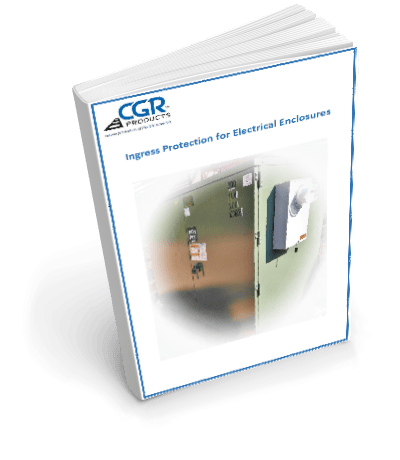Since CGR Products’ founding in 1963, we’ve worked with design engineers to bring projects to life, and we do everything we can to make that process efficient, affordable and successful. CGR uses a wide variety of converting methods and equipment to create parts and designs with precision and efficiency
Enclosure Protection
Enclosure gaskets are mechanical parts used to provide weatherproof seals on electrical enclosures and its doors. The typical method of attaching the gaskets is by means of a chemical fastener such as pressure sensitive adhesives (PSA). The mating surfaces many times can be irregular. In order to protect the sensitive electronic equipment inside the enclosure, a properly selected and manufactured gasket is critical. The enclosures can be used indoors or outdoors; therefore, a properly selected material and design are essential to ensure proper performance and long life. Generally, gaskets are used to seal out dust, dirt, water, Electromagnetic Interference (EMI), and Radio Frequency (RFI). Gaskets can also be used to dissipate vibration.
Industry Testing
Water: Direct spray tests are conducted. These tests can be a drip test, pressure hose test, or submersion test. UL requires that no water enter the unit during any of these tests. Full submersion tests can require up to 24 hours of submersion with zero entry of moisture.
Oil Swell: The gasket material is submerged in oil for 24 hours. The gasket material cannot swell over 25% of its original dimension or shrink more than 1%.
Tensile & Elongation: Some NEMA tests require tensile and elongation retention. For tensile and elongation the gasket materials are aged for 1 week @ 70 degrees C (158 F). After completion, the new and aged gasket materials are compared. To pass the tensile test the aged gasket material must stretch 75% of the same length as the new material before breaking. Elongation requires that the amount of force needed to break the aged material must be at least 75% of the new material.
Other tests include water absorption, compression deflection, and compression set. Contact CGR Products for a more detailed explanation for all of these industry tests.
For a FREE downloadable PDF version to keep for your records:
Download the full version of Ingress Protection for Electrical Enclosures here
Gasket Design
Die Cut Gaskets:
Die cutting is the general process of using a die or tooling to shear webs of low-strength materials, such as rubber, fiber, foam, paper, paper, plastics, thin metals, and pressure-sensitive adhesive tapes.
Die cutting can produce a precise shape with no seams. These gaskets form around the entire perimeter of the enclosure or the sealing surface. These type of gaskets can be supplied individually, in sheets, kiss-cut on rolls, or in strips, with or without pressure sensitive adhesives for mounting.
Strip Gasketing:

This method is the oldest. Supplied in rolls, the manufacturers of the enclosures adhere strips of the gasket material to the enclosure surface to be sealed. One side of the gasket material will have a pressure sensitive adhesive designed to adhere to the enclosure structure. The corners are not sealed due to the strip design. This method is the most economical but the corners are areas of concern for some applications.
Fold- out / Dovetail Gasket

In instances of very large enclosures, high volumes, or the design does not allow for strip gaskets, a fold-out or dovetail gasket may be an option. The fold-out gasket allows the die cut to be expanded to its final shape, eliminating the center scrap. A dovetail gasket works in a similar fashion, except the corners are mitered and fit together comparable to a jigsaw puzzle. The design of the enclosure and level of ingress protection needed will determine if this type of gasket is suitable.
Material Selection
Elastomeric materials are the most common and affordable materials used for enclosure gaskets and seals. These materials are available in foams, sponge, foam blends, and cork blends, with and without pressure sensitive adhesives. The key to choosing a gasket material is defining the environment in which it must perform. One must consider temperature / thermal management requirements, UV and Ozone exposure, EMI / RFI resistance, just to name a few.
What can CGR Products do for you?
CGR Products can assist in suggesting a material for an electrical enclosure. We have worked with many enclosure manufactures over the last 50 years. The full CGR Resource Library and team of experts are available to clients with specifications, cost charts, comparative material information and more. Our design team works with automotive, marine, appliance, plastic molding, power tool, electrical, small engine and countless other clients.
Our in-house tool and die capabilities mean maximum problem solving with minimal lead times, and an extensive inventory of raw materials supports projects of all kinds. Safety stocks are in place with our inventory of raw materials, and consultation with our experienced staff is always available to get you started.
For a FREE downloadable PDF version to keep for your records:
Download the full version of Ingress Protection for Electrical Enclosures here
Learn More
Consider CGR Products when you are developing your enclosure protection. With over 170,000 square feet of manufacturing and warehouse space and over 100 top-quality machines, CGR serves a diverse range of clients, including those in the electrical enclosure industry.
To request a quote for your next gasket click Here or visit our Sample Gallery to view a portfolio encompassing all the industries we serve.

